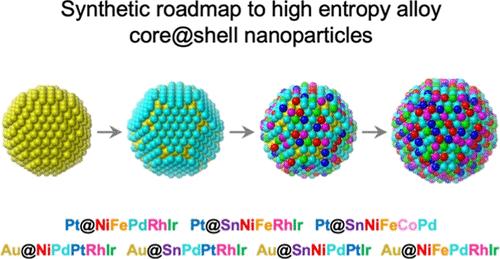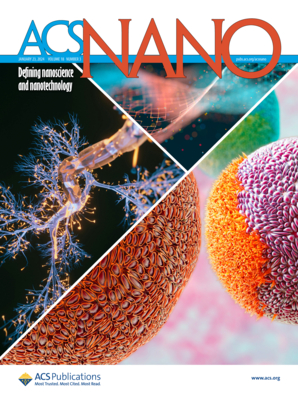Influence of Nanoparticle Seeds on the Formation and Growth of High Entropy Alloys during Core@Shell Nanoparticle Synthesis
IF 15.8
1区 材料科学
Q1 CHEMISTRY, MULTIDISCIPLINARY
引用次数: 0
Abstract
The growth of inorganic shells on nanocrystal seeds to form core@shell nanoparticles is well-known to enhance and improve properties and performance, and therefore is foundational to many applications. High entropy alloys, which contain five or more metals in near-equal amounts, are emerging as important materials due to their synergistic properties. Integrating high entropy alloys into the shells of core@shell nanoparticles has the potential to combine and expand the benefits of both. However, the compositional complexity of high entropy alloys complicates shell growth because of the many competing reactions and byproducts that are possible. Here, we report a synthetic protocol for growing high entropy alloy shells on metal nanoparticle seeds, along with mechanistic insights from time-point studies that define guidelines for controlling core@shell nanoparticle composition, thickness, and growth modes. By studying the growth of NiPdPtRhIr, SnPdPtRhIr, and SnNiPdPtIr shells on Au seeds and NiFePdRhIr shells on both Au and Pt seeds, we find that the seed modifies the reaction pathways and accelerates the formation of high entropy alloys compared to when they are synthesized directly in the absence of a seed. We also identify competing reactions that produce freestanding multimetallic particles instead of the desired high entropy alloy shells, as well as evidence for galvanic exchange and ripening processes that contribute to shell growth. Based on these insights, we compiled a synthetic roadmap of design rules that was then applied to the design and synthesis of additional high entropy alloy shells, including SnNiFeRhIr and SnNiFeCoPd, that expand compositional tolerance relative to what can be achieved through direct synthesis.

求助全文
约1分钟内获得全文
求助全文
来源期刊

ACS Nano
工程技术-材料科学:综合
CiteScore
26.00
自引率
4.10%
发文量
1627
审稿时长
1.7 months
期刊介绍:
ACS Nano, published monthly, serves as an international forum for comprehensive articles on nanoscience and nanotechnology research at the intersections of chemistry, biology, materials science, physics, and engineering. The journal fosters communication among scientists in these communities, facilitating collaboration, new research opportunities, and advancements through discoveries. ACS Nano covers synthesis, assembly, characterization, theory, and simulation of nanostructures, nanobiotechnology, nanofabrication, methods and tools for nanoscience and nanotechnology, and self- and directed-assembly. Alongside original research articles, it offers thorough reviews, perspectives on cutting-edge research, and discussions envisioning the future of nanoscience and nanotechnology.
 求助内容:
求助内容: 应助结果提醒方式:
应助结果提醒方式:


